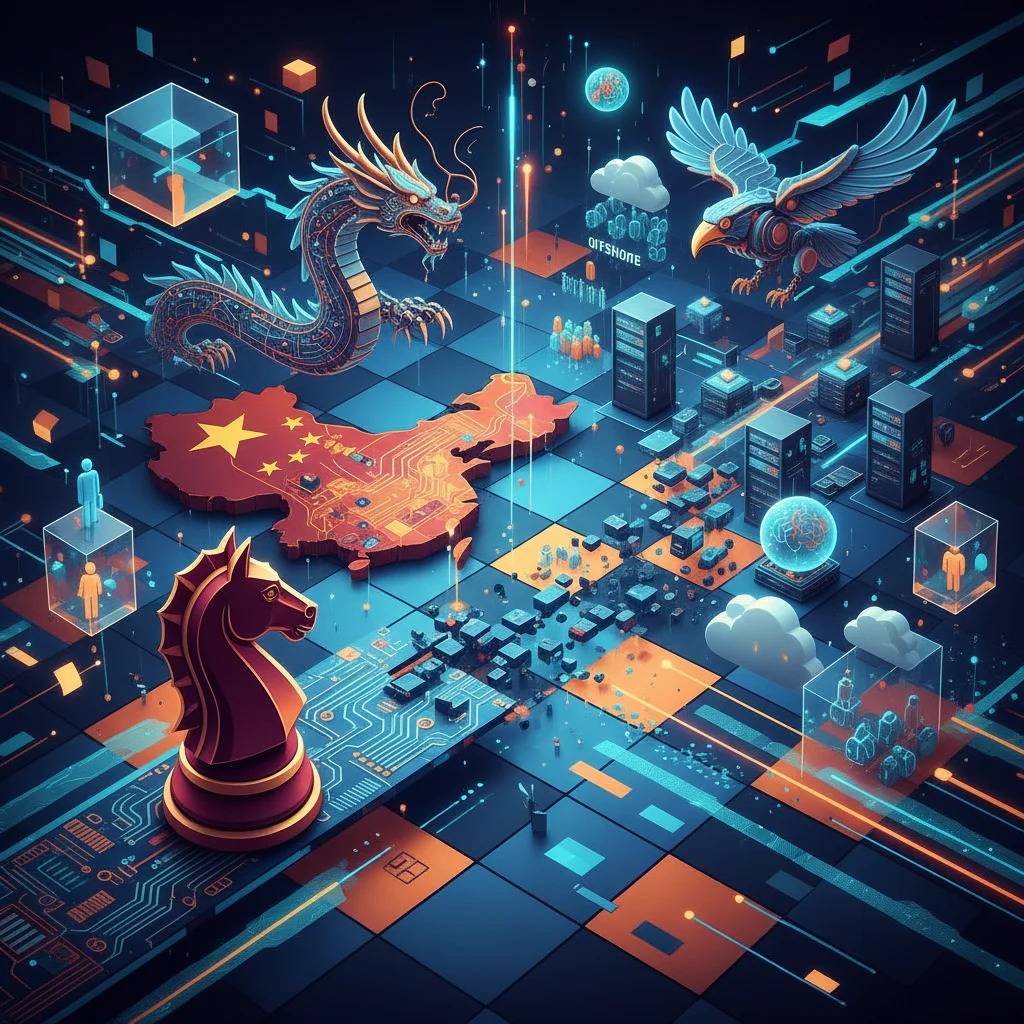
Geopolitical Chess: The Great Offshore Migration of Chinese AI
In the high-stakes world of artificial intelligence, the race to build the most powerful models is relentless. It’s a competition that hinges on three key ingredients: massive datasets, brilliant minds, and, most critically, raw computational power. For years, the undisputed king of that power has been Nvidia, whose advanced GPUs are the engine behind today’s generative AI revolution. But what happens when the world’s most populous nation is cut off from the world’s best tools? You get a plot twist worthy of a spy thriller.
Chinese tech giants, facing a tightening blockade of US sanctions on high-end chips, are not waving the white flag. Instead, they’re engaging in a sophisticated game of geopolitical chess. According to a revealing report from the Financial Times, companies like Alibaba and ByteDance (the parent company of TikTok) are executing a clever workaround: they’re moving their AI model training operations offshore. By setting up shop in places like Singapore, they can legally access the very Nvidia chips that are banned from being sold into mainland China. This isn’t just a minor logistical shift; it’s a fundamental reshaping of the global AI development landscape, with profound implications for innovation, talent, and the future of technology itself.
The Golden GPUs: Why Nvidia Chips Are Non-Negotiable
To understand the gravity of this situation, you first need to appreciate why these specific chips are so crucial. We’re not talking about the graphics card in your gaming PC. We’re talking about enterprise-grade behemoths like Nvidia’s A100 and H100 Tensor Core GPUs. These are the Ferraris of the computing world, specifically designed for the colossal parallel processing tasks required for machine learning and training large language models (LLMs).
Training a model like GPT-4 or its Chinese counterparts requires sifting through trillions of data points and adjusting billions of parameters. This process, which can take months and cost hundreds of millions of dollars, is computationally brutal. The A100 and H100 chips are architected to handle these tasks with unparalleled efficiency. Using less powerful alternatives isn’t just slower; for cutting-edge models, it can be practically impossible. They are, quite simply, the essential hardware for anyone serious about competing at the top tier of AI development.
The US government, recognizing this dependency, has made these chips a key chokepoint in its strategy to slow China’s technological and military advancement. The export controls, first introduced in 2022 and tightened since, effectively created a “chip wall,” blocking Chinese companies from directly purchasing these critical components.
Don't Tax Innovation: Why the Future of Electric Vehicles is a Software-Defined Problem
The Offshore Gambit: How the Workaround Works
So, if you can’t bring the chips to your developers, you bring your developers to the chips. That’s the core of the strategy being deployed by China’s tech titans. The plan is as elegant as it is audacious:
- Establish a Presence: Chinese companies establish or expand their operations in neutral-ground tech hubs, with Singapore being a prime destination.
- Rent, Don’t Buy: They partner with international or local cloud computing providers—or even US-based ones operating in the region—that have data centers stocked with the coveted Nvidia H100s.
- Remote Development: Their AI research and programming teams then access this computational power remotely to train their next-generation AI models.
- Import the “Brain”: Once the model is fully trained, the finished software—the model’s weights and architecture, which is essentially just data—can be transferred back to China for deployment in their domestic products and services.
This strategy cleverly sidesteps the letter of the US law, which restricts the sale of hardware *to* China, but doesn’t yet explicitly prohibit Chinese companies from renting computing power on that same hardware located *outside* of China. As one industry executive noted, this move is crucial for Chinese firms to “keep up with the pace of AI model iteration” (source). It’s a high-stakes solution that highlights the desperation and ingenuity driving the global tech race.
To better visualize the strategic trade-offs, let’s compare the two approaches for a Chinese AI company:
| Factor | Onshore Development (in China) | Offshore Development (e.g., Singapore) |
|---|---|---|
| Hardware Access | Limited to less powerful, sanctioned-compliant chips or a gray market. | Full access to state-of-the-art Nvidia H100/A100 GPUs via cloud rental. |
| Operating Costs | Lower staff and facility costs, but extremely high prices for scarce, smuggled chips. | Higher costs for cloud compute and international talent, but predictable pricing. |
| Geopolitical Risk | Directly impacted by current and future US sanctions. | Risk of future US sanctions expanding to cover cloud access for Chinese firms. |
| Talent Pool | Access to a vast domestic talent pool, but risk of brain drain. | Ability to attract a global talent pool, potentially accelerating innovation. |
| Cybersecurity & Data | Data remains within national borders, aligning with data sovereignty laws. | Complex cybersecurity and data privacy challenges; training data must be moved offshore. |
Furthermore, this creates a fascinating paradox. US cloud giants like Amazon AWS, Microsoft Azure, and Google Cloud, who are all operating in Singapore, could find themselves in a position where they are indirectly fueling the AI development of the very companies their government is trying to constrain. It’s a messy, complicated situation that highlights the tension between national security policy and the global, borderless nature of cloud technology and SaaS business models. This isn’t just a supply chain issue; it’s the frontline of the 21st-century tech cold war.
The Ripple Effects: More Than Just a Chip Problem
The decision to move AI development offshore isn’t just a technical one; it sends powerful ripples across the entire tech ecosystem.
First, there’s the issue of **talent**. The most brilliant minds in AI want to work with the best tools. By moving cutting-edge projects to hubs like Singapore, Chinese companies risk creating a “brain drain,” where their top researchers and engineers follow the hardware. As one venture capitalist mentioned, “The smartest people will go where the best chips are” (source). This could have long-term consequences for China’s domestic innovation ecosystem.
Second, this pivot accelerates the rise of **Southeast Asia as a neutral tech battleground**. Singapore, in particular, is positioning itself as the Switzerland of the digital age—a stable, well-connected hub where capital, talent, and data from both East and West can converge. This influx of investment from Chinese tech giants will supercharge the region’s digital economy.
Third, it underscores the immense challenge facing Chinese **startups**. While behemoths like Alibaba and ByteDance have the resources to fund expensive offshore operations, smaller AI startups are left in a much tougher position. They are forced to make do with less powerful domestic chips, potentially falling further behind in the race to build foundational models. This could lead to a consolidation of power, where only the largest, most well-funded companies can truly compete on the global stage.
Nvidia's AI Tsunami: Why Their Staggering Revenue Is More Than Just a Number
The Long Game: A Fragmented Future for AI?
The great offshore migration of Chinese AI is more than just a clever corporate strategy. It’s a symptom of a deeper, more troubling trend: the fragmentation of the global technology landscape. For decades, the world of tech was defined by open collaboration and shared standards. Now, we are seeing the emergence of distinct, and often competing, technological spheres of influence, carved out along geopolitical lines.
While China is aggressively investing in its domestic chip industry, developing a true alternative to Nvidia’s market-leading GPUs is a monumental task that will take years, if not a decade. In the meantime, the offshore strategy is a pragmatic, if precarious, bridge to the future. It allows Chinese companies to stay in the game, continue their R&D, and avoid being lapped by their Western counterparts.
This ongoing chess match is a stark reminder that the future of automation and artificial intelligence won’t be shaped by code and algorithms alone. It will be forged in the crucible of geopolitics, supply chain logistics, and the relentless human drive for innovation, no matter the obstacles. The world is watching to see who will make the next move.
Nvidia's AI Empire: Deconstructing the Billion Quarter That Shook the Tech World


